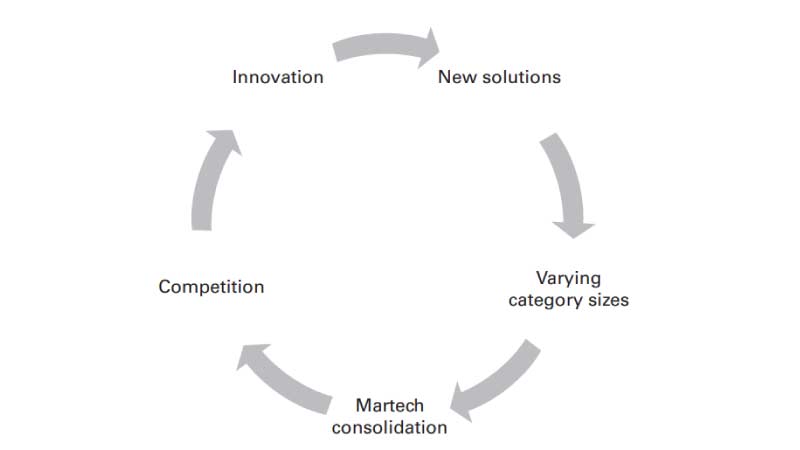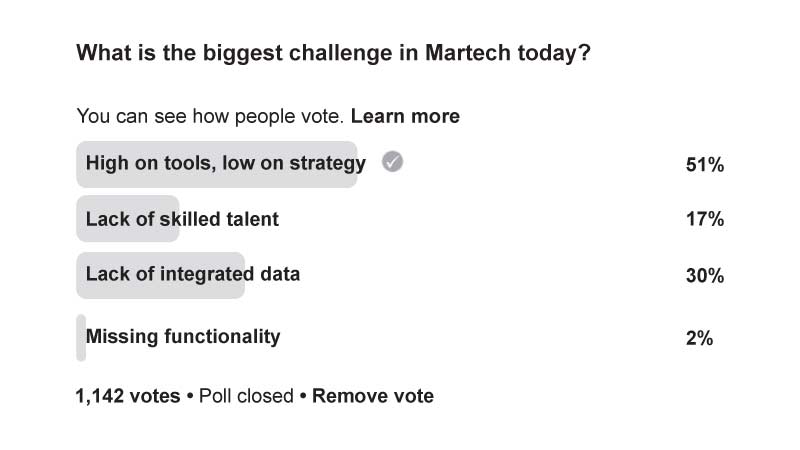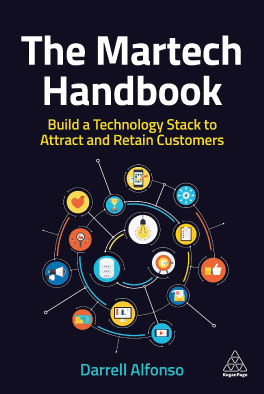Dealing with The Too-Many-Tools Challenge
Darrell Alfonso’s latest book, The Martech Handbook, promises critical insights into tackling marketers’ biggest woes. Martech as an Industry The terms I would use to describe the Martech industry are: exciting, staggering, fast-growing, and a bit overwhelming. In 2019, Clickz estimated the value of Martech in the North American and UK markets as $65.9 billion, […]
Topics
What to Read Next
- TripleLift Announces Partnership with Attain to Unify Context and Commerce
- Seedtag Partners with IRIS.TV to Expand Contextual Signals for CTV Targeting
- Magnite, Cognitiv Announce Deep Learning Integration for Real-Time Curation
- Dscout Announces Integration with HeyMarvin
- Comscore Launches Program-Level Capabilities within CCM

Darrell Alfonso’s latest book, The Martech Handbook, promises critical insights into tackling marketers’ biggest woes. 
Martech as an Industry
The terms I would use to describe the Martech industry are: exciting, staggering, fast-growing, and a bit overwhelming. In 2019, Clickz estimated the value of Martech in the North American and UK markets as $65.9 billion, and globally at $121 billion (Collins, 2019). In terms of growth, what once was an industry of 150 Martech tools in 2011, shot up to over 8,000 Martech tools in 2021. That is an explosion of Martech. You can actually see all 8,000 listed on the Chief Martec website (https://chiefmartec.com/).
As shown in Figure 1.1, each component of the Martech industry evolves to drive it forward:
Competition: While tremendously exciting for marketers around the world, and especially those selling Martech services, this can be quite overwhelming when deciding which Martech tools to use and how. The industry is also incredibly competitive—many categories of tools have dozens of options with almost identical functionality and pricing. Let’s take an example from the Martech 5000 database; a public, free database that lists out the majority of Martech tools available. In the category “content and experience” and sub-category of “email marketing,” there are 223 companies to choose from.

Of the ones I’ve had the pleasure of working with, I know that Mailchimp, Constant Contact, Campaign Monitor, and Emma all have fairly comparable monthly and annual plans to pick from. So, which do you use?
Varying category sizes: One other distinguishing characteristic of the Martech industry is that some of the categories play a much bigger role than others, and often take up more of the Martech budget. Examples of these categories are email marketing, marketing automation, and data management. When it comes to smaller categories, such as video marketing and influencer marketing tools, marketing teams will pay significantly less. To give a real example of the differences, “marketing automation” as a category is large and are typically over six figures a year in cost. Since this is a larger, more mature category, it has since been dominated by large software companies. Some of the main players in this space are Marketo, owned by Adobe, Pardot by Salesforce, Eloqua by Oracle, and Silverpop by IBM.
Emergence of marketing clouds: At the time of writing, the large software vendors such as Adobe, Salesforce, and Oracle are working on building “marketing clouds.” Marketing clouds are a suite of Martech platforms that serve a variety of marketing needs and are owned by the same company. While you don’t necessarily log onto the same portal to access all of these services, the added benefit is better interconnectivity between the services and a single vendor contract. Only time will reveal if there will eventually be one dominant marketing cloud to “rule them all.”
Always new solutions: An exciting feature of the Martech land scape is that there are new categories and platforms emerging all the time, as digital continues to disrupt marketing and the business marketplace at large. Many of these new platforms only have a handful of features and benefits they offer but are relatively inexpensive and quick to implement, providing immediate value to the marketing team. There are even many “point solutions”—a service that only provides one primary business value. For example, Sigster, acquired by Terminus, helps marketers put ads in employee signatures. UTM.io is another example, and its sole purpose is to help marketers organize UTM parameters. While these point solutions help marketers move quickly and save time, it has the added consequence of creating massive Martech stacks that are difficult to manage and govern.
Potential Dangers When Working with Martech
While Martech may seem like all the buzz, and it can indeed help you and your marketing team increase your effectiveness and scale exponentially, there are some common problems that often arise. These pitfalls can plague marketing teams of all sizes, regardless of the experience of the team:
- buying too many tools;
- shiny object syndrome;
- underutilizing/shelfware;
- being feature-driven versus strategy-driven.
-
Buying Too Many Tools
In a LinkedIn poll of over 1,000 marketers, 51 percent of respondents said that the biggest challenge in Martech today was too many tools and too little strategy (Figure 1.2).

The lure of marketing technology, especially today, is that there is a tool for everything. Most problems that marketers are facing have a corresponding point solution out there in the marketplace. And with the plethora of tools to choose from, compounded by technology becoming more advanced and affordable, it can be tempting to string together any and all tools to help get our work done. The problem with this strategy is that it can get quickly out of hand, lead to an incoherent strategy, and worse, a discontinuous customer experience because of all the different platforms you are using to engage and measure their behavior.
-
Shiny Object Syndrome
One thing we know about marketers (myself included) is that we love new things. We love exciting new platforms that promise new ways of engaging customers and making our lives easier. Whether it be a new tool to advertise on the latest social media platform or an integration tool to connect all of our projects and work together in a seamless way, the lure of purchasing something that can change our work life is a very human feeling. The challenge becomes that these shiny new objects may not fit in with our overall Martech or marketing strategy, and may not be what is best for engaging customers long term. But we can’t help but be tempted…
-
Underutilizing Technology (Shelfware)
When marketing teams subscribe to too many tools, what often happens is that many of these tools go unused. An example could be a testing tool that the team purchased last year doesn’t conduct any tests or a data management tool that is hardly utilized because data initiatives are deprioritized. These tools have been satirically referred to as “shelfware” because they sit on a hypothetical shelf, going unused by the marketing team that expected to realize value from it.
The cause of this is twofold: first, it is the aforementioned issues of purchasing too many tools and grabbing the latest shiny new object. Second, it is the lack of Martech talent—people who know how to technically and strategically get the most value out of each tool and set them up for success—and an overall cohesive Martech strategy to deliver return on investment (ROI) for each platform.
-
Being Feature-Driven versus Strategy-Driven
Another common temptation is to use all the features that Martech has to offer. Some of the large marketing automation platforms boast hundreds of marketing features that teams can leverage to drive impact with their work. The problem? Not all of these features are useful, and in some specific business cases, very few are. But the motivation of getting a return on expensive software, and using everything a platform has to offer, is very tempting. Unfortunately, marketers can get too caught up in trying to use the features and forget what the goal of using those features was in the first place. The answer to this tragedy? To set your marketing objectives first, and then select the features and tools that will help you achieve them.
I painfully remember an example of how being feature-driven versus strategy-driven can negatively impact business. I remember being so excited about being the lead administrator for a marketing automation platform for a medium-sized business. The first thing I did? Figure out all the features and functionality that my team wasn’t using and started to put them into place. After several months I had tried out the different bells and whistles with little success and was confronted by a very tough question by my leader: “What did we accomplish these past few months?” he asked intently, curious since I seemed so busy. My heart fell flat. The truth was, while I was consumed with busy work, trying to implement all the features that the platform had to provide, I realized that I never stopped and asked the key questions: What is most important? What are we trying to achieve? And which features and tech would it take to get us there? Needless to say, that conversation didn’t go very well, and it is still a strong reminder of why we need to always think about our goals, objectives, and strategy before we think about trying out new tools.
The author of The Martech Handbook: Build a Technology Stack to Attract and Retain Customers, Darrell Alfonso, Global Marketing Operations, AWS, will be speaking on the second day of the fourth edition of Vibe Martech Fest, Middle East which will take place on September 06 and 07, 2022.
The Martech Handbook by Darrell Alfonso is © 2022 and reproduced by permission of Kogan Page Ltd. All rights reserved
If you liked reading this, you might like our other stories
Chronic Versus Acute Disruption
For The Marketer’s Book Shelf










































































































